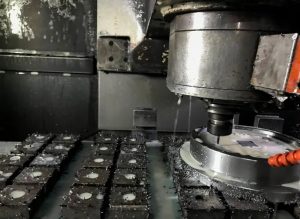This article talks about one of cnc machining services,CNC milling stands out as a pivotal process in manufacturing, celebrated for its diverse fabrication and milling capabilities. While its versatility has made it a cornerstone in numerous industries, it’s imperative to delve into the nuanced landscape of CNC milling, dissecting both its strengths and limitations. This article aims to provide an in-depth understanding of CNC milling, its wide-ranging applications, and a balanced evaluation of its advantages and drawbacks.

Understanding CNC Milling:
CNC milling represents an automated process where a cutting tool shapes a workpiece. Its adaptability extends across various materials, including plastics, aluminum, wood, and glass. The fundamental setup involves securing the workpiece on the machine’s table while the cutting tool, tethered to the spindle, executes rotational movements.
Operational Dynamics of Milling Machines:
Milling machines are versatile entities with the capacity to undertake an array of tasks, encompassing processing planes, creating grooves, producing gear components, crafting spiral surfaces, and shaping curved surfaces. The productivity of these machines is notably high due to their multi-edge intermittent cutting capability, functioning as a multifaceted tool for milling, drilling, and boring diverse workpieces.
Applications of CNC Milling:
The applications of CNC milling are widespread, spanning critical sectors like aerospace, automotive, medical, electronics, and mold making. Its precision and adaptability make it an indispensable tool for manufacturing intricate components, facilitating the creation of high-quality outputs.
Advantages of CNC Milling:
- Precision and Repeatability:
- CNC milling machines offer exceptional accuracy, ranging from 0.01 mm to 0.03 mm.
- Consistent repeatability (tolerances between 0.003 mm to 0.01 mm) ensures the faithful reproduction of parts, elevating efficiency.
- High Efficiency:
- CNC mills, equipped with rotating carousels holding up to 30 tools, enable swift and efficient cutting processes.
- Rapid production turnaround, with parts ready in a matter of hours, reducing time compared to conventional methods.
- Complex Geometries:
- The capability of CNC milling machines to craft intricate and complex part designs fosters innovation.
- Reduced Cost:
- Rapid and precise manufacturing without the need for expensive tools or materials.
- Single-operator efficiency diminishes labor expenses.
Drawbacks of CNC Milling:
- Material Wastage:
- The subtractive manufacturing approach leads to more material wastage compared to additive processes.
- Initial Investment Cost:
- High-quality CNC milling machines can pose a significant upfront investment, potentially hindering small businesses or individuals.
- Complexity and Training:
- Specialized skills are requisite for operating and programming CNC milling machines, contributing to increased costs and learning curves.
- Maintenance and Downtime:
- Regular maintenance and calibration are vital, and unplanned downtime can disrupt production schedules.
- Software and Programming Errors:
- Mistakes in programming or software glitches can result in machining errors, leading to scrap parts and material wastage.
Conclusion:
CNC milling undeniably offers a host of advantages in precision and efficiency, positioning itself as a cornerstone in modern manufacturing. However, a nuanced understanding of its drawbacks, such as material wastage and training intricacies, is crucial for making informed decisions. The selection between CNC milling and alternative machinery hinges on specific applications, with considerations like accuracy and complexity favoring milling machines, while speed may influence alternative methods. Striking this balance ensures optimal productivity and efficiency for businesses navigating the intricate realm of manufacturing.
